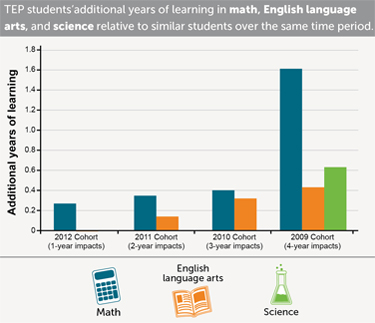The Equity Project Charter School: Impacts on Student Achievement
Key Findings:
- By the end of the 2012–2013 school year, TEP’s impacts on student achievement were consistently positive across subjects and cohorts, with especially large effects in math.
- Compared to similar students in comparable New York City public schools, students who attended TEP for four years had test score gains equal to an additional 1.6 years of school in math, an additional 0.4 years of school in English language arts, and an additional 0.6 years of school in science.
 This report describes The Equity Project (TEP) charter school’s instructional and personnel strategies, examines the characteristics and attrition rates of TEP students, and measures TEP’s impacts on student achievement during the school’s first four years of operation. TEP has a unique approach to rewarding and developing high quality teachers—including salaries of $125,000 and substantial professional responsibility—while receiving only the standard public funds available to any New York City charter school. Mathematica found that by the end of the 2012–2013 school year, TEP’s impacts on student achievement were consistently positive across subjects and cohorts, with especially large effects in math. Using benchmarks for average annual learning gains, the research team found that, compared to similar students in comparable New York City public schools, students who attended TEP for four years had test score gains equal to an additional 1.6 years of school in math, an additional 0.4 years of school in English language arts, and an additional 0.6 years of school in science. TEP’s student population is similar to those of other schools in the neighborhood, high poverty and mostly Hispanic, and TEP students are as likely to receive special education services as students in other New York City public schools.
This report describes The Equity Project (TEP) charter school’s instructional and personnel strategies, examines the characteristics and attrition rates of TEP students, and measures TEP’s impacts on student achievement during the school’s first four years of operation. TEP has a unique approach to rewarding and developing high quality teachers—including salaries of $125,000 and substantial professional responsibility—while receiving only the standard public funds available to any New York City charter school. Mathematica found that by the end of the 2012–2013 school year, TEP’s impacts on student achievement were consistently positive across subjects and cohorts, with especially large effects in math. Using benchmarks for average annual learning gains, the research team found that, compared to similar students in comparable New York City public schools, students who attended TEP for four years had test score gains equal to an additional 1.6 years of school in math, an additional 0.4 years of school in English language arts, and an additional 0.6 years of school in science. TEP’s student population is similar to those of other schools in the neighborhood, high poverty and mostly Hispanic, and TEP students are as likely to receive special education services as students in other New York City public schools.
How do you apply evidence?
Take our quick four-question survey to help us curate evidence and insights that serve you.
Take our survey
